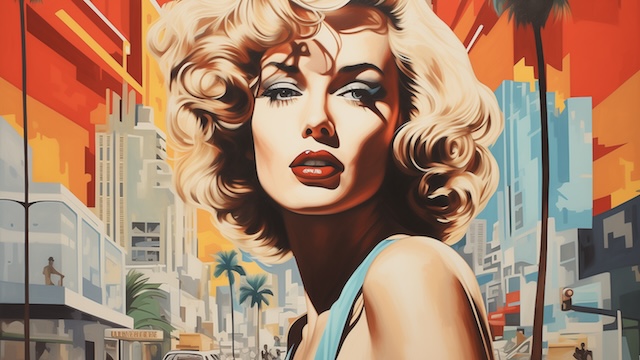Hollywood and Its Glamorization of White Supremacy

When we sit down to watch a movie or television show, it isn’t often that we consider the potentially deeper meaning behind what we are watching. Cinema is, for most people, purely entertainment---analyzing said content is only for the avant-garde or the most puritanical film snobs. But if someone were to tell you that Hollywood was used to propagate the myth of white supremacy, especially during the Golden Age of the studio system, would you be surprised?
Hollywood in the 20th century was an entirely different beast to the current state of the industry today. Back in those days, stars were literally made, molded and formed into the perfect “star”. People would be plucked, quite literally, off the street to go through months of intense training ranging from elocution classes, dance lessons, strict dieting, screen testing and plastic surgery. Anyone who has ever told you that stars back then were not as plastic as stars today were right in many ways but also very, very wrong. Yes, old Hollywood stars were talented, they were beautiful and they were mysterious, but it was all a carefully crafted glamour to deceive audiences.
However, the most insidious fact about all of this is that Hollywood was, for a very long time, reserved only for white actors or people who were willing or able to pass as white. Stars like Merle Oberon were forced to hide their ethnic heritage, sometimes artificially lightening their skin and bleaching their hair to conform to standards of “whiteness”. Rita Hayworth, star of Gilda and ex-wife of Orson Welles, was actually ethnically Spanish Roma, which in her early career was used to market her as being more “exotic”. However, when the studios decided it was time for her to become a more traditional silver screen star, she began her transformation by changing her name from Margarita Cansino to Hayworth and bleaching her naturally brown hair strawberry blonde (some say it was a light auburn). Additionally, she underwent painful electrolysis treatments to lift her forehead as it was perceived to be too low and too "ethnic looking" by the studios. Even Marilyn Monroe, often lauded as the ideal white American, blonde beauty, was not as “white” as she claimed, having Mexican heritage on her mother’s side. It was also later revealed that she had indeed undergone plastic surgery, sculpting her chin and possibly fixing her nose into the preferred button shape.
If there were minorities on the silver screen, they were heavily stereotyped and pigeonholed with various taglines: "spitfire Latinas", "duplicitous Orientals", "animalistic Africans", "mysterious Arabs". Black characters were always the happy, dumb slaves, servants, or mammies, following behind their white mistresses like puppy dogs while shucking and jiving for the amusement of white audiences across the country. If they were male, they were still slaves, servants or sometimes tap dancing fools, dancing beside young white stars such as Shirley Temple as Bill "Bojangles" Robinson was made to do, an early iteration of the Magical Black Sidekick trope still prevalent in contemporary Hollywood. In Breakfast at Tiffany’s, director Blake Edwards saw it fit to keep in the yellowface caricature of Holly Golightly’s Japanese landlord, Mr. Yunioshi, played by the widely celebrated Mickey Rooney. Bucktoothed, perverted, speaking with an incredible lisp, it’s one of the dark spots on an otherwise lovely film that both Edwards and Rooney later admitted to regretting. White actors would also paint their faces in shiny black shellac, drawing grotesquely large, pink lips onto themselves, mocking African features. Judy Garland herself once donned blackface, singing a traditional negro spiritual (Swing Low, Sweet Chariot), nappy wig and all, and no one batted an eyelash.
Of course, the most egregious example of Hollywood’s history with white supremacy would be D.W. Griffith’s Birth of a Nation, a literal sweeping epic to racism and the Ku Klux Klan, with the KKK benefitting greatly from the film's release as interest in the group surged. Yes, the film in many ways revolutionized the industry, with its innovative filming techniques, complex narrative and sweeping cinematography. But of course its legacy will always be marred by the director's sympathies for a white South (Griffith was himself a virulent racist). One scene in particular shows a “black” man (it's actually another white actor in blackface, go figure) being lynched by an angry white mob of KKK knights---all holding Templar shields---after he attempts to marry a white woman. Another film that has left a sour taste in the mouths of many would be the overly long but certainly aesthetically beautiful Gone with the Wind, a romanticized vision of the antebellum South and plantation culture. For her part, Hattie McDaniel, the actor who played Scarlett O'Hara's maid Mammy, won an Oscar for her role, becoming the first Black American to do so.
Of course, people do not need to stop watching movies due to racism and prejudice, or that films be censored because of offensive content, as Hollywood's stereotyping issues extend well beyond race. However, there must be a critical appraisal of Hollywood's frequent use of typecasting and the narratives embedded within the media that we consume, not just with race, but with class and gender, as this imagery has a much deeper influence on the collective consciousness than many realize. There is also space to discuss the frequently negative portrayals of women on the silver screen, such as Pop Culture Detective's excellent breakdown on the fetishization of child-like women in science fiction media. This article intends to point out the conception that Old Hollywood represents a more innocent, carefree, and happier time period in the history of the United States is dangerously naïve, if not borderline propagandistic in nature. Plus, the struggles minorities still face within the industry today do not exist within a vacuum---they have a basis in history, and are a part of a long legacy of segregation that has existed since its inception.





